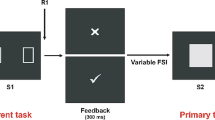Abstract
Subjects monitored the repetitive presentation of pairs of vertical lines (events) for one of two kinds of critical signals: a) pairs in which one of the lines was longer than the other (simultaneous task), or b) pairs in which both lines were longer than usual (successive task). The events to be monitored appeared in a temporally regular manner (synchronous events) or under two conditions of temporal irregularity (event asynchrony). Perceptual sensitivity (A’) for critical signals was degraded by event asynchrony when discriminations were made in the successive mode, but not in the simultaneous mode. The results support the hypothesis that successive tasks place a greater load on attentional capacity than do simultaneous tasks.
Access this chapter
Tax calculation will be finalised at checkout
Purchases are for personal use only
Preview
Unable to display preview. Download preview PDF.
Similar content being viewed by others
References
Davies, D. R., & Parasuraman, R. (1982). The psychology of vigilance. London: Academic Press.
Dittmar, M. L., Warm, J. S., & Dember, W. N. (1985). Effects of knowledge of results on performance in successive and simultaneous vigilance tasks: A signal detection analysis. In R. E. Eberts and C. G. Eberts (Eds.), Trends in Erogonomics/Human Factors II (pp. 195–202). Amsterdam: Elsevier Science Publishers (North-Holland).
Dittmar, M. L., Zieleniewski, A. M., Dember, W. N., Warm, J. S., Tudor, L., & Lysaght, R. J. (1986). Effects of signal regularity upon performance in simultaneous and successive vigilance tasks. Proceedings of the Human Factors Society (pp. 950–954). Santa Monica, CA.: Human Factors Society.
Grier, J. B. (1971). Non-parametric indexes for sensitivity and bias: computing formulas. Psychological Bulletin, 75, 424–429.
Jerison, H. J. (1970). Vigilance, discrimination and attention. In D. I. Mostofsky (Ed.), Attention: contemporary theory and analysis (pp. 127–147). New York: Appleton-Century-Crofts.
Joshi, A., Dember, W. N., Warm, J. S., & Scerbo, M. W. (1985). Effects of event rate and spatial uncertainty on performance insimultaneous and successive vigilance tasks. Paper presented atthe meeting of the Psychonomic Society, Boston, Massachusetts, November.
Lanzetta, T. M., Warm, J. S., Dember, W. N., & Berch, D. B. (1985). Information processing load and the event rate function in sustained attention. Proceedings of the Human Factors Society (pp. 1084–1088). Santa Monica, CA.: Human Factors Society.
McDermott, B. E., Dember, W. N., Warm, J. S., & Feichtner, S. L. (1986). Information processing demands in sustained attention. Paper presented at the Third Mid-Central Ergonomics/Human Factors Conference, Miami University, Oxford, OH, June.
Nuechterlein, K. H., Parasuraman, R., & Jiang, Q. (1983). Visual sustained attention: Image degradation produces rapid sensitivity decrement over time. Science, 220, 327–329.
Parasuraman, R., & Mouloua, M. (in press). Interaction of signal discriminability and task type in vigilance decrement. Perception & Psychophysics.
Richter, D.O., Senter, R. J., & Warm, J. S. (1981). Effects of the rate and regularity of background events on sustained attention. Bulletin of the psychonomic Society, 18, 207–210.
Scerbo, M. W., Warm, J. S., & Fisk, A. D. (in press). Event asynchrony and signal regularity in sustained attention. Current Psychological Research & Reviews.
Warm, J. S., Chin, K., Dittmar, M. L., & Dember, W. N. (in press). Effects of head restraint on signal detectability in simultaneous and successive vigilance tasks. Journal of Psychology.
Warm, J. S., & Jerison, H. J. (1984). The psychophysics of vigilance. In J. S. Warm (Ed.), Sustained attention in human performance (pp. 15–59). Chichester: Wiley.
Wesnes, K., Warburton, D. M., & Matz, B. (1983). Effects of nicotine on stimulus sensitivity and response bias in a visual vigilance task. Neuropsychobiology, 9, 41–44.
Author information
Authors and Affiliations
Editor information
Editors and Affiliations
Rights and permissions
Copyright information
© 1987 Springer-Verlag New York Inc.
About this chapter
Cite this chapter
Scerbo, M.W., Warm, J.S., Doettling, V.S., Parasuraman, R., Fisk, A.D. (1987). Event Asynchrony And Task Demands In Sustained Attention. In: Mark, L.S., Warm, J.S., Huston, R.L. (eds) Ergonomics and Human Factors. Recent Research in Psychology. Springer, New York, NY. https://doi.org/10.1007/978-1-4612-4756-2_3
Download citation
DOI: https://doi.org/10.1007/978-1-4612-4756-2_3
Publisher Name: Springer, New York, NY
Print ISBN: 978-0-387-96511-6
Online ISBN: 978-1-4612-4756-2
eBook Packages: Springer Book Archive




